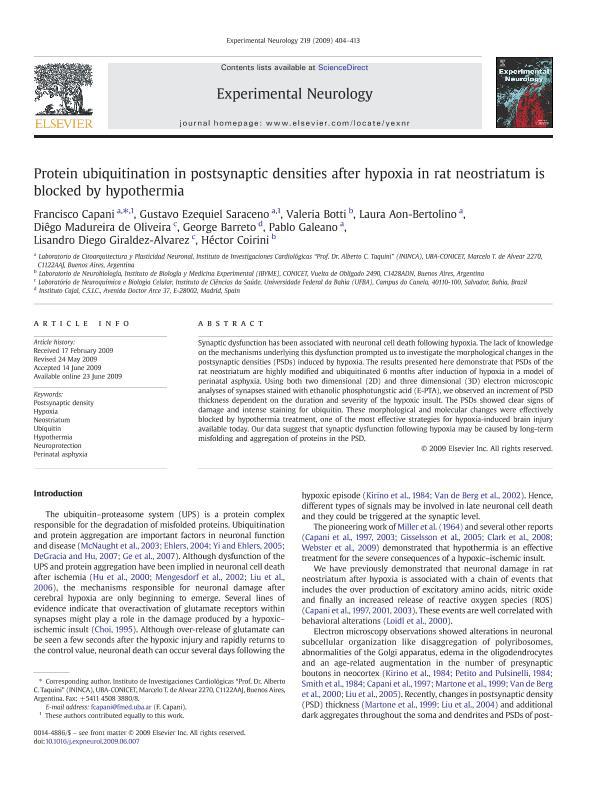Artículo
Protein ubiquitination in postsynaptic densities after hypoxia in rat neostriatum is blocked by hypothermia
Capani, Francisco ; Saraceno, Gustavo Ezequiel
; Saraceno, Gustavo Ezequiel ; Botti, Valeria; Aon Bertolino, Maria Laura
; Botti, Valeria; Aon Bertolino, Maria Laura ; Madureira de Oliveira, Diego; Barreto, George; Galeano, Pablo; Giraldez Alvarez, Lisandro Diego; Coirini, Hector
; Madureira de Oliveira, Diego; Barreto, George; Galeano, Pablo; Giraldez Alvarez, Lisandro Diego; Coirini, Hector
 ; Saraceno, Gustavo Ezequiel
; Saraceno, Gustavo Ezequiel ; Botti, Valeria; Aon Bertolino, Maria Laura
; Botti, Valeria; Aon Bertolino, Maria Laura ; Madureira de Oliveira, Diego; Barreto, George; Galeano, Pablo; Giraldez Alvarez, Lisandro Diego; Coirini, Hector
; Madureira de Oliveira, Diego; Barreto, George; Galeano, Pablo; Giraldez Alvarez, Lisandro Diego; Coirini, Hector
Fecha de publicación:
2009
Editorial:
Elsevier
Revista:
Experimental Neurology
ISSN:
0014-4886
e-ISSN:
1090-2430
Idioma:
Inglés
Tipo de recurso:
Artículo publicado
Clasificación temática:
Resumen
Synaptic dysfunction has been associated with neuronal cell death following hypoxia. The lack of knowledge on the mechanisms underlying this dysfunction prompted us to investigate the morphological changes in the postsynaptic densities (PSDs) induced by hypoxia. The results presented here demonstrate that PSDs of the rat neostriatum are highly modified and ubiquitinated 6 months after induction of hypoxia in a model of perinatal asphyxia. Using both two dimensional (2D) and three dimensional (3D) electron microscopic analyses of synapses stained with ethanolic phosphotungstic acid (E-PTA), we observed an increment of PSD thickness dependent on the duration and severity of the hypoxic insult. The PSDs showed clear signs of damage and intense staining for ubiquitin. These morphological and molecular changes were effectively blocked by hypothermia treatment, one of the most effective strategies for hypoxia-induced brain injury available today. Our data suggest that synaptic dysfunction following hypoxia may be caused by long-term misfolding and aggregation of proteins in the PSD.
Palabras clave:
Ap
,
Neostriatum
,
Synapse
,
Hypoxia
Archivos asociados
Licencia
Identificadores
Colecciones
Articulos(IBYME)
Articulos de INST.DE BIOLOGIA Y MEDICINA EXPERIMENTAL (I)
Articulos de INST.DE BIOLOGIA Y MEDICINA EXPERIMENTAL (I)
Citación
Capani, Francisco; Saraceno, Gustavo Ezequiel; Botti, Valeria; Aon Bertolino, Maria Laura; Madureira de Oliveira, Diego; et al.; Protein ubiquitination in postsynaptic densities after hypoxia in rat neostriatum is blocked by hypothermia; Elsevier; Experimental Neurology; 219; 2; -1-2009; 404-413
Compartir
Altmétricas



